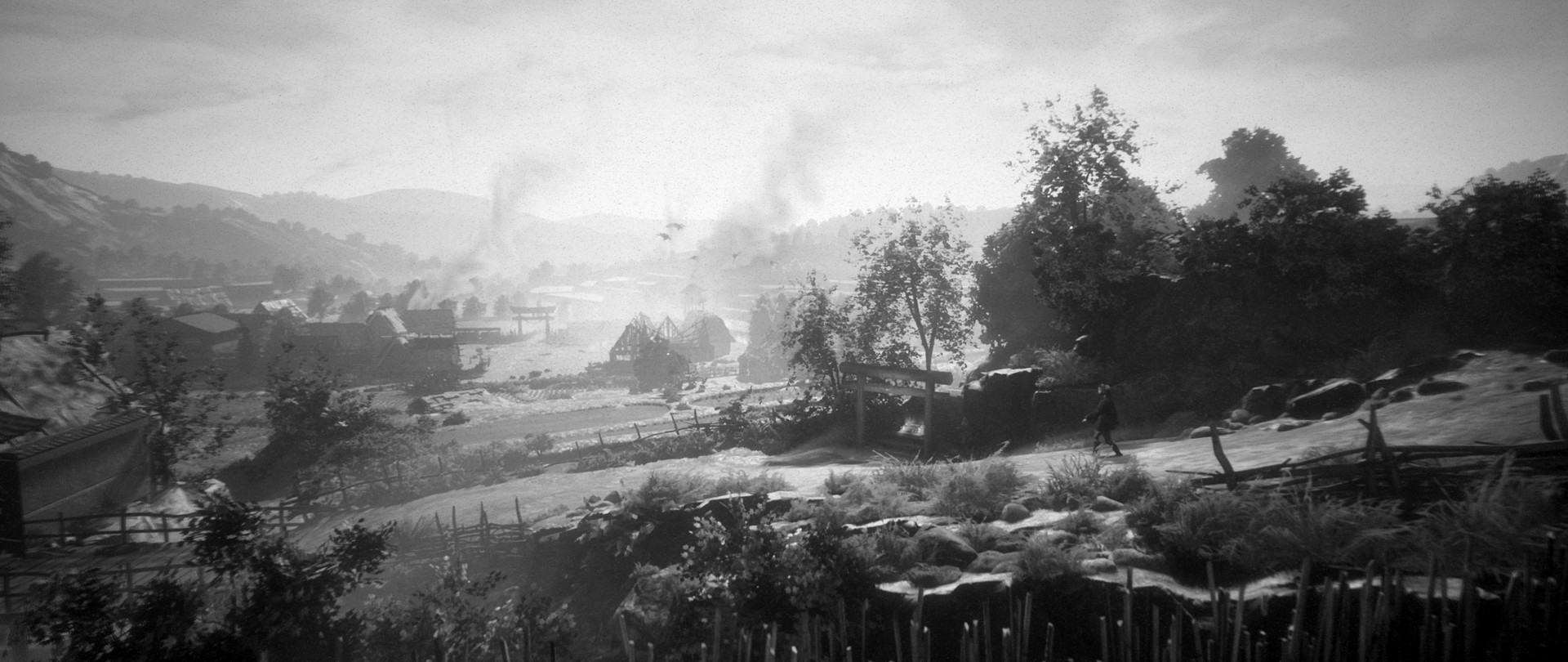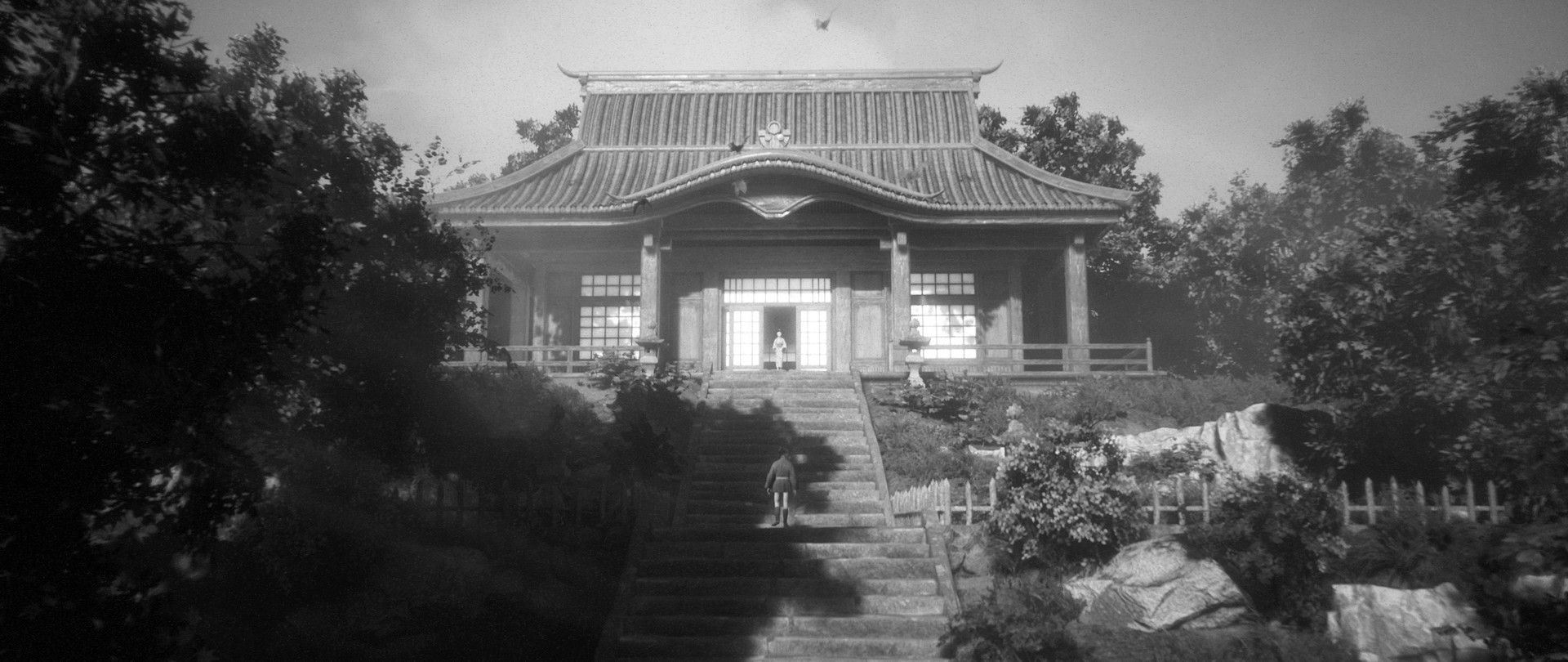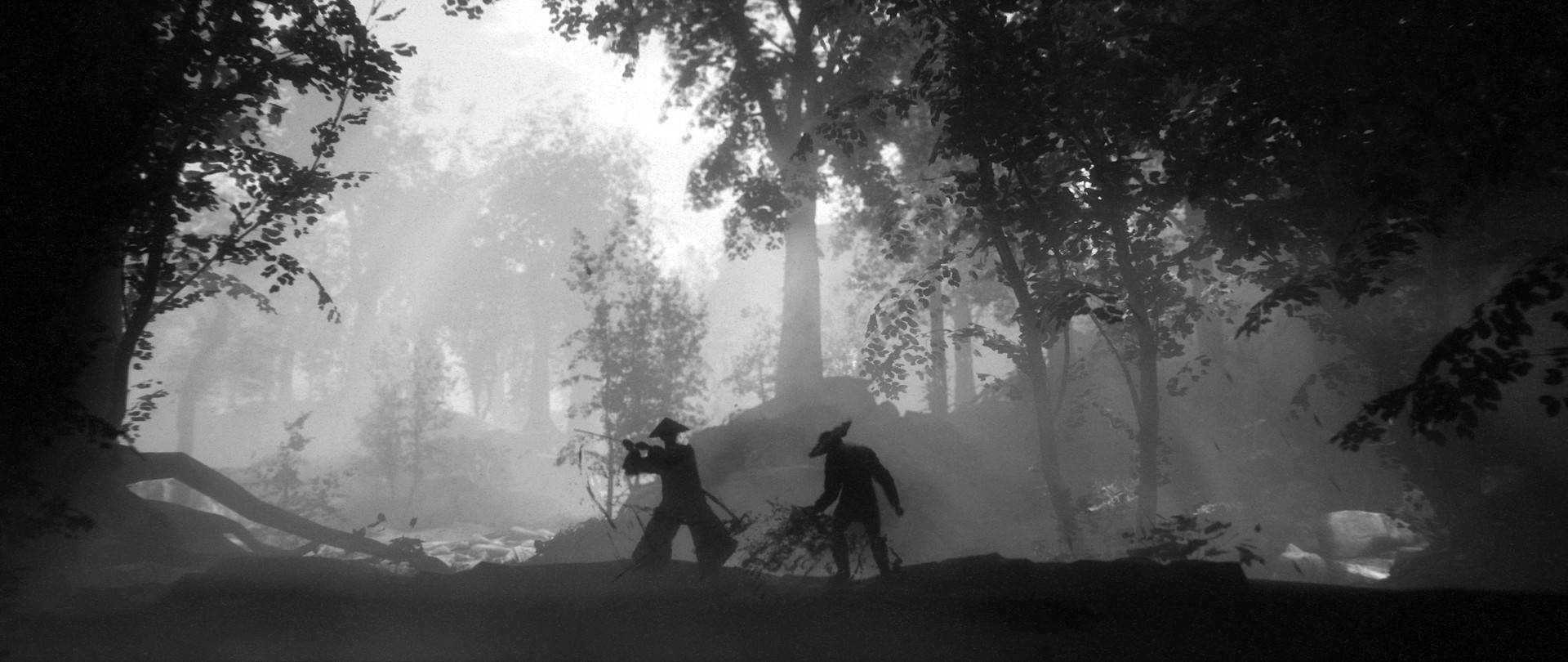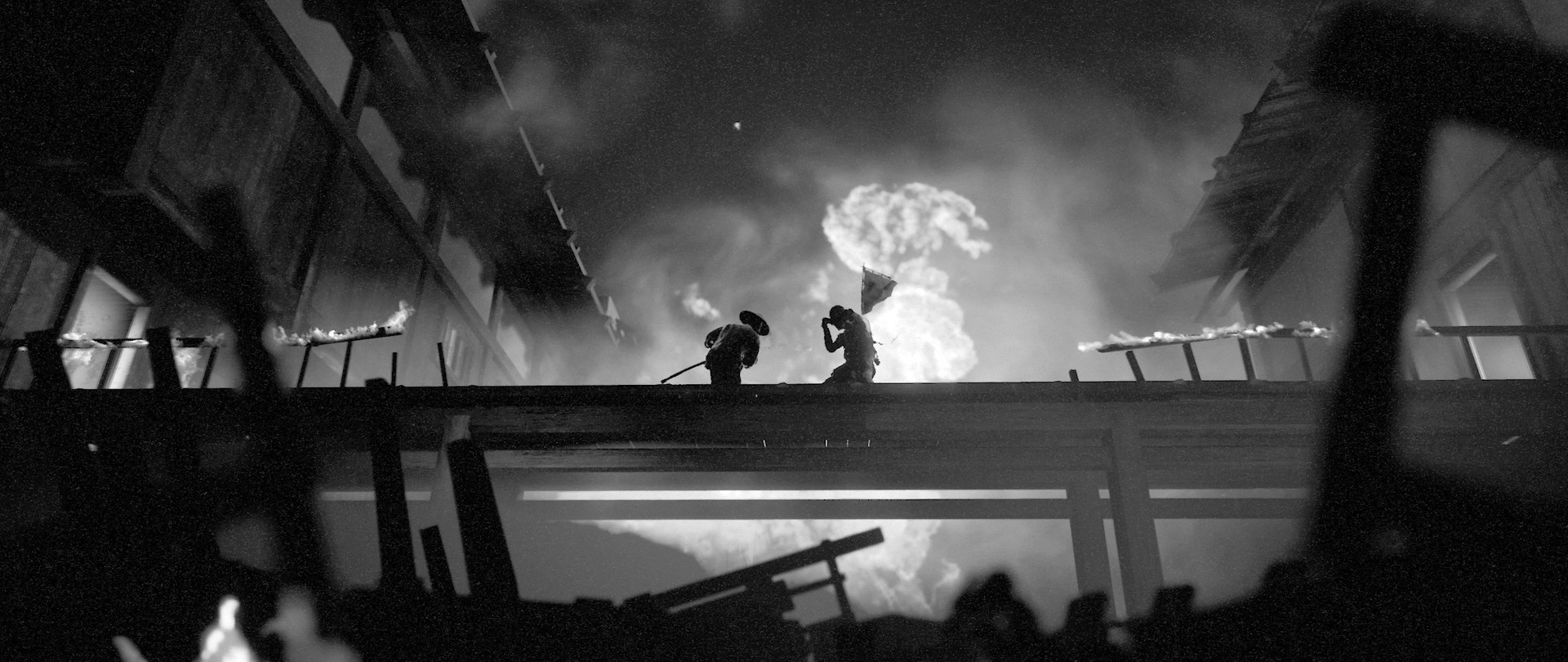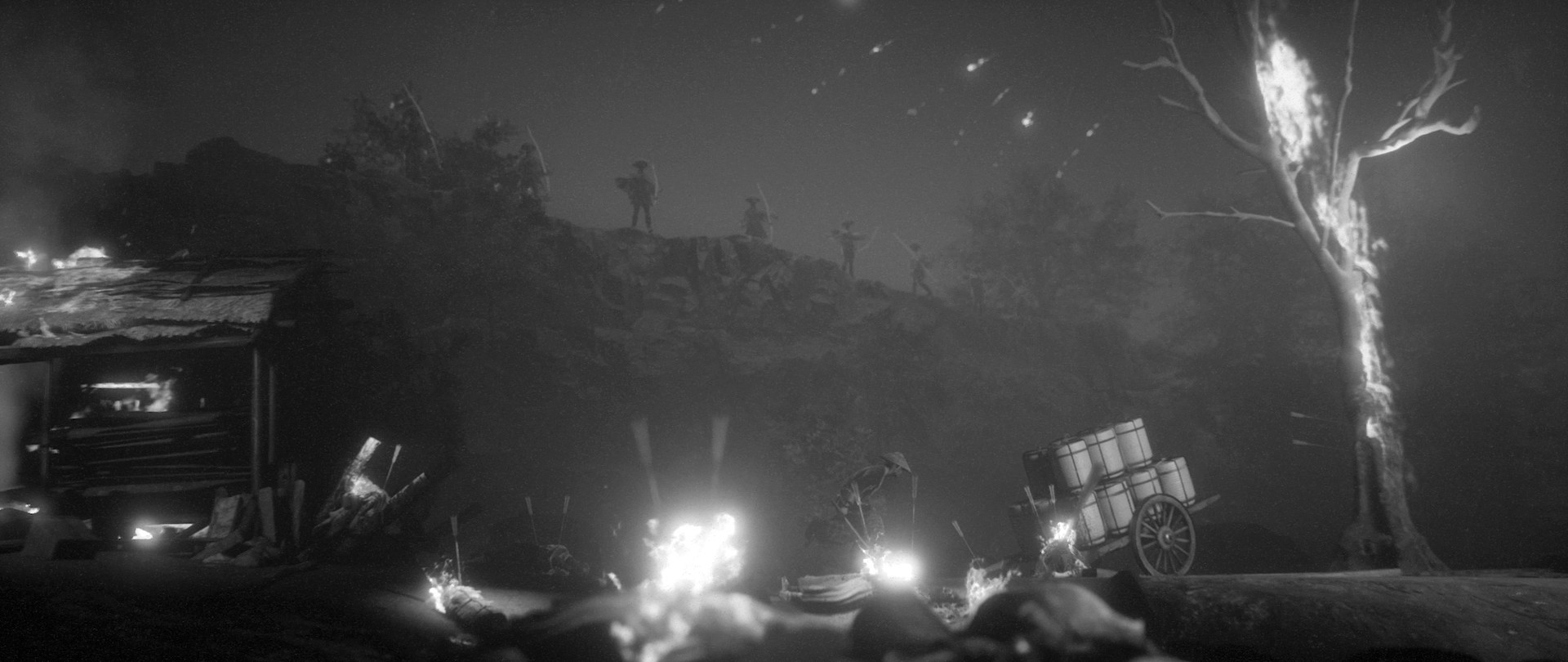Having only recently written up a preview for Trek to Yomi, I have a clear point of comparison for my thoughts before and after playing it. A lot of the concerns I had ended up being justified, and while everything I loved about my time previewing the game remains true in the final release, there were also a number of unpleasant discoveries.
Trek to Yomi is a 2.5D side-scrolling action game where you play as Hiroki, a young samurai lord on a quest for revenge. As you can tell from the screenshots the game is entirely in black and white, and many areas feature fixed camera angles allowing for a delightful focus on the artful framing of scenes. This aping of epic samurai cinema from the 50s and 60s is Trek to Yomi’s biggest strength, which is why it’s such a shame that the rest of the game largely fails to impress.
The level of detail, especially in the opening few levels is commendable. Trek to Yomi makes a great first impression as you weave through the marketplaces, warehouses, taverns, and alleyways of Hiroki’s hometown. Townsfolk mutter stories about their families, the state of trade, or rumours of bandits attacking another town. A merchant’s wagon collapses as you pass, spilling his wares onto the ground and if you stop to speak to the poor man Hiroki will offer to help him clean up later. These small events give the sense that this game will be rich in story, with plenty of narrative details and side events to be discovered by those paying close attention.
Then the bandits launch an attack on Hiroki’s town, and the true focus of the game emerges: combat, combat, and more combat. From roughly the third level onwards my hopes for the game being a linear but a dynamic, story-rich side-scroller with lots of spectacular scripted events quickly fell away. What eventuates is an extremely uneven combat gauntlet where the story very abruptly takes a backseat.
So why is it a problem that a samurai action game consists mostly of combat? A fair question, let’s get into it.
You have light and heavy attacks, and can block, parry, dodge roll, and perform combos. At first, this feels great, capturing the essence of the deadly balancing act that is a samurai duel; if you make one wrong move, whether that’s parrying or attacking early or leaving your back exposed, you’ll quickly find yourself bleeding to death in the dirt.
Unfortunately, as the game goes on, the combat fails to evolve in an engaging way. In fact, the level design, enemy variety, and especially boss fights actively work against what makes the combat an interesting premise in the first place.
You unlock new combos through exploration or defeating particular enemies (which is a supremely arbitrary way to reward a player when defeating said enemy is the only way to progress) as well as a handful of ranged attacks. The combos range from useless to overpowered, and I found myself sticking to one or two that when utilised correctly, would stun enemies, leaving them open to a one-hit-kill execution.
Because stunning and executing enemies in this way is so simple and efficient, there’s absolutely zero reason to engage with the other facets of the game’s combat. A combat system is at its best when you’re encouraged to adapt to new situations as your skillset expands or you’re met with different kinds of enemies, but Trek to Yomi never really goes there. It’s quite content to throw the same stuff at you again and again for the entirety of its 5-6 hour duration.
It would be one thing if Trek to Yomi’s combat was just boring and repetitive, it’s another thing entirely that several specific encounters, and most of the boss fights, are borderline broken. Whether it’s the I-frames of your dodge roll being completely impossible to gauge, an enemy’s attack animation being nigh unreadable, or the hitbox of an enemy’s sword extending further than it should, I rarely felt challenged, and I frequently felt frustrated.
In addition, Trek to Yomi commits the cardinal sin of having boss fights not really requiring the player to use all the skills they’ve learned up until that point. Parrying, blocking, and in some cases even dodge rolling become entirely useless. What eventuates are extremely frustrating battles of attrition that rely mostly on getting lucky with which attacks the boss decides to use.
Now, there was a day one patch for the game that I was able to download in the hours leading up to the review embargo. It’s possible that they’ve polished a lot of the issues I’ve mentioned above but, because there is no chapter select, I am unable to go back into the game and check the boss fights without playing through the whole thing again. Aside from checking out improvements from patches, no chapter select also makes it impossible to return to specific levels to clean up any collectibles you might have missed, which is a bummer.
The story takes a supernatural turn around halfway through, but this has essentially no impact on the actual gameplay. The setting and enemy types change a little, but nothing particularly interesting is done with either. The visual aesthetic goes from having a distinct, clear focus on evoking black and white samurai movies to a generic ghostly vibe with ethereal caves and wastelands. The black and white at that point becomes an obstacle to visual quality rather than an enhancement. It’s a really perplexing pivot especially when Trek to Yomi starts off so strong in this regard.
There’s a particularly egregious sequence towards the end of the game where you must traverse a series of floating rocky islands in a spooky void, but everything on the islands is a mish-mash of objects and building styles from earlier levels in the game. It really just feels like padding.
Beyond the underwhelming supernatural side of the game, the core story ends up feeling familiar and vapid. The beginning promises a little more, there are scripted events like farmers trying to stop bandits smashing through the town gates, or a horseman cutting down a man in front of horrified peasants. That sense of being part of an unfolding narrative gradually slips away and by the time you venture into Yomi itself, it’s gone altogether. This is instead replaced with endless self-pitying monologues from Hiroki and the previously mentioned repetitive gameplay.
The annoyances unfortunately don’t end there either. The game uses a checkpoint system and a lot of these feel needlessly punishing. Say there’s a tough combat encounter shortly after a simple puzzle, every time you die in that tough encounter you will also have to repeat the puzzle. Or, there might be a puzzle that results in death if you fail to solve it in time that follows a tough combat encounter. You may get through the combat only to die to a stupid sneaky puzzle and have to do both all over again. I really don’t understand what would’ve been lost by autosaving immediately before each combat encounter.
With all of that said, Trek to Yomi’s musical score is another strong point I want to mention. Composers Cody Johnson and Yoko Honda prioritised authenticity and historical accuracy by only using instruments that were available during Japan’s Edo period. This adds a lot to the experience and is definitely something worth celebrating about this game.
I really wanted to adore Trek to Yomi and on paper it does everything right, combining my love of mythology, history, cinema, and video games. It gives a strong first impression with its stunning visual style, deceptively linear, intricate level design, and thrilling combat. Before too long however the façade comes crashing down and what starts out feeling like a lovingly curated, experimental cinematic homage, turns into a clunky, visually bland slog. Add to this some seemingly endless, repetitive combat, no eventuating story to speak of, and near-broken boss fights to round out the experience. With great and genuine dismay, I must admit that Trek to Yomi is the utter definition of style over substance.
Rating: 6/10
Trek to Yomi was reviewed on PC via Steam using a review code provided by the publisher.


